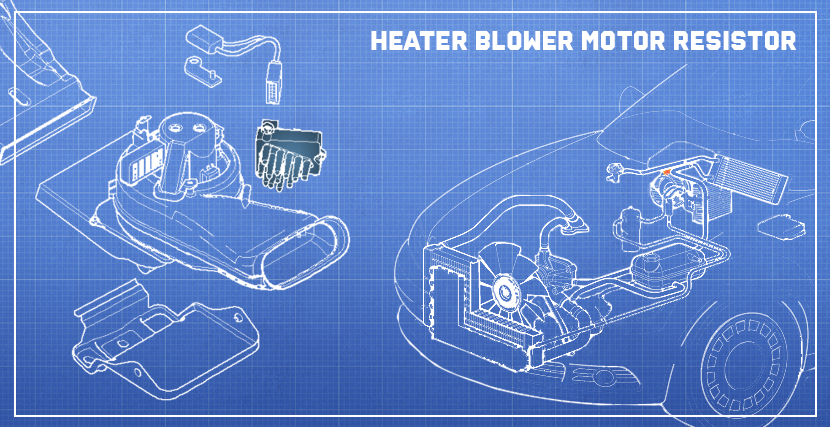Heater Blower Motor Resistor
Whether you drive a vehicle with a manually operated climate control system or a fully automated one, you have an ability to adjust the heater blower motor speed to meet your current needs. This is possible thanks to a heater blower motor resistor, which allows the fan to spin at different speeds. Depending on the position of the climate controls or signals received from the climate control module, the heater blower motor resistor cuts some power supplied to the fan which slows it down. To make the fan run at its maximum speed the heater blower motor resistor is bypassed, allowing all voltage to reach the motor. By contrast, when the fan is off, no power is supplied to the heater blower motor via the resistor.

Depending on the type of the air conditioning system you have, the heater blower motor resistor can be found at different locations. Thus, manual air conditioning systems feature the resistor that is attached directly to the dashboard switch operated by the driver. Fully automated climate control systems usually come equipped with a heater blower motor resistor located somewhere in the ventilation system, which allows for better heat dissipation. On the newest vehicles, the heater blower motor resistor comes as an integral part of the climate control nodule.
Regardless of the type of your air conditioning system, problems caused by a failing heater blower motor resistor can keep the A/C system from performing its function. This may affect not only your driving comfort but also your safety if you drive in cold weather conditions. Since the proper airflow is crucial for quick and efficient defrosting of the windshield, a failed resistor shouldn’t be neglected. Here are some tips which should help you to understand that your heater blower motor resistor is about to fail:
- Your heater blower motor doesn’t work
- Not all fan speeds are available
- The fan can run at the maximum speed only
- You can’t turn off the fan
- Smoke or smell coming from the vents
Heater blower motor resistor troubleshooting and replacement
Your heater blower motor resistor is designed to handle power demands as well as to absorb and dissipate heat produced during its operation. Obviously, being exposed to such hard operation conditions, it is prone to wear and failures due to overheating, vibrations, corrosion, moisture, short circuits, etc.
Whichever the cause of a climate control system problem, all related electrical components must be inspected for wear and damage before replacing the resistor. It is better to leave this job to a professional mechanic who has a corresponding knowledge and necessary equipment to provide a diagnosis. If the source of the problem is a bad resistor, the mechanic will replace it with a new one. In most cases, the resistor is easy to access; however, removing some dashboard components may be required. If a bad resistor sits inside the climate control module, you may need to replace the entire module to fix the problem.
Working on your climate control system, the mechanic may also recommend you to replace some other system components if they’re about to fail or worn-out. Replacing such components can save you a lot of headache and money in the long run.
Once again, we do not recommend you to replace a bad heater blower motor resistor yourself if you don’t have a specific knowledge and equipment. You may not only damage dashboard components or climate control system parts but also miss a failing component that needs a replacement. This is especially important if you have a fully automated computer-control air conditioning system which is very complex. It requires special diagnostic equipment as well as a sophisticated knowledge and experience to deal with.